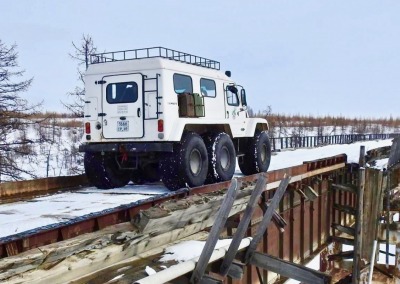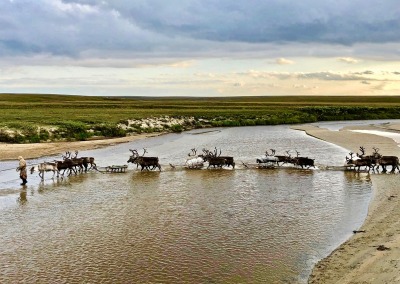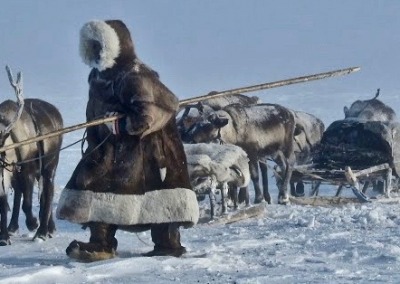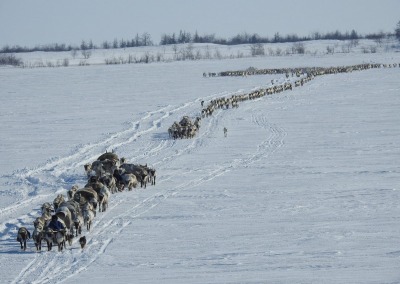Nenets religion
The Nenets have an animistic and shamanistic religion. There are three worlds – the upper, the middle and the lower. The middle world is where people live. The upper world is where the god of the sky, Num, lives. His name is the same as the Nenets word for weather, which shows how important the elements are to people who live outdoors in such an extreme climate. The lower world is inhabited by Num’s evil brother, Nga. The eternal battle between Num and Nga represents both the struggle of the Nenets and their reindeer herds to survive and also the constant changing of the seasons. In winter Nga holds sway, whereas in summer it is Num.
Both the upper and the lower worlds have seven levels. Seven is a sacred number for the Nenets and is encountered again and again in relation to their spiritual beliefs. The sacred reindeer sledge, for example, has seven pairs of stanchions, whereas all other sledges have between three and five.
Shamans had the power to travel between the worlds and ask for help for people in the middle world. However, the last really powerful shamans died around thirty years ago. This is because they were persecuted as religious leaders under Stalin and young people simply stopped becoming shamans. There remain, however, a number of half-shamans who are known only to their own relatives. They are able to provide assistance similar to that of the old shamans.
While the upper world is inhabited mostly by gods, the middle world is inhabited by a huge number of spirits that can influence the lives of people. Many animals, places and natural phenomena have their own spirits. Particularly sacred places will often have a pile of reindeer skulls and antlers up to three metres high. The most important ones may have several such piles surrounded by polar bear skulls and carved wooden idols. The most important sacred site is called Severn Chums and is located on the northern coast of the Yamal Peninsula. No foreigner has ever set eyes on it, although one Russian anthropologist did manage to make it there.
When migrating past a sacred site, people will leave offerings there. These can be as small as a piece of cloth or some butter. However, if anyone has slaughtered a reindeer while camped nearby they may leave the skull or antlers at the site. If anyone’s sacred sledge or sacred chum pole is in need of replacing, they may leave the old one at a sacred site if there is one nearby.
As mentioned above, there are also a number of sacred sites and objects at any Nenets encampment. A chum is supported by a skeleton of 33 wooden poles. One of these stands slightly further out than the rest and this is considered a sacred pole. Nobody, men or women, may cross between the sacred pole and the chum wall. Women, or anyone affected by sya mei (see below) may not cross between the sacred pole and the fire.
Also within the chum can be found a number of idols. The smaller ones represent Nenets gods while the larger ones can be either a chum protector spirit or a one of the family’s particularly powerful ancestors, for example a shaman. The gods and ancestors are passed down via the man’s family. The chum protector idol is passed down via the woman’s family. Most of them are carved of wood and dressed in their own reindeer fur clothing, with the exception of the chum protector idol which has no actual substance inside the
clothing. Sometimes the idols have their own tools and jewellery and are even given presents by the family. Sometimes they are given a place at the table during meal times.
Materials for making new clothes for the idols are kept outside on the sacred sledge along with some other idols, including quite big ones with carved wooden faces. Under normal circumstances guests would never see the contents of the sacred sledge, as it is opened only in great need.
A very important aspect of the Nenets worldview is called sya mei. This is a force from the other world, that of birth and death, which can be dangerous in this world. People connected with birth and death are affected by sya mei, for example newborn children, anyone who has recently been at a funeral and all post-pubescent women. When a child is born in a chum a reindeer must be sacrificed next to the door and its blood smeared on the floorboards or the ground. People returning from a funeral must perform a special cleansing ceremony where they dance over a bowl of burning fur and grasses. Women must constantly watch their behaviour, as there are a huge number of taboos which, if broken, can bring bad luck to the family. If a woman breaks any of these taboos, she must perform the same cleansing ceremony described above.
If one pays attention, one can spot Nenets women around camp observing certain taboos several times every day. Others are much less obvious. Among the easily noticeable ones are:
- She must not step over ropes, lassoes, herding poles or men’s equipment. You will often see women passing ropes over their head rather than stepping over it.
- She must not cross an invisible line between the sacred chum pole and the fire. This line also extends out into the tundra and she must not cross it within site of the chum. So if she is behind the chum and needs to cross a few feet to the other side, she must walk all the way around the front rather than crossing directly.
- She must not step over men while they are lying down in the chum. Likewise she must not hang her fur boots up to dry in the chum, as a man could then walk under them and it would be like she had stepped over him.
- A woman must never wear a man’s fur boots, but she can wear his fur coat. As you can see, many taboos are to do with the legs or stepping. This is because the lower part of a woman’s body is the part which gives birth, the part most affected by sya mei.
- Other less obvious ones are that they must not visit sacred sites, cannot cut certain fish, must not cross a bear’s tracks, must not step over a pregnant dog, and so on.
To visit Nenets who have preserved their ancient religion, as well as traditions like the sacred pole, sacred sledge and idols, you really need to visit Nenets in the Yar-Sale or Seyakha areas. Nenets closer to Salekhard or in the Polar Ural Mountains have often been somewhat Russified or converted to Christianity, so you are much less likely to see these things.
The Nenets have an animistic and shamanistic religion. There are three worlds – the upper, the middle and the lower. The middle world is where people live. The upper world is where the god of the sky, Num, lives. His name is the same as the Nenets word for weather, which shows how important the elements are to people who live outdoors in such an extreme climate. The lower world is inhabited by Num’s evil brother, Nga. The eternal battle between Num and Nga represents both the struggle of the Nenets and their reindeer herds to survive and also the constant changing of the seasons. In winter Nga holds sway, whereas in summer it is Num.
Both the upper and the lower worlds have seven levels. Seven is a sacred number for the Nenets and is encountered again and again in relation to their spiritual beliefs. The sacred reindeer sledge, for example, has seven pairs of stanchions, whereas all other sledges have between three and five.
Shamans had the power to travel between the worlds and ask for help for people in the middle world. However, the last really powerful shamans died around thirty years ago. This is because they were persecuted as religious leaders under Stalin and young people simply stopped becoming shamans. There remain, however, a number of half-shamans who are known only to their own relatives. They are able to provide assistance similar to that of the old shamans.
While the upper world is inhabited mostly by gods, the middle world is inhabited by a huge number of spirits that can influence the lives of people. Many animals, places and natural phenomena have their own spirits. Particularly sacred places will often have a pile of reindeer skulls and antlers up to three metres high. The most important ones may have several such piles surrounded by polar bear skulls and carved wooden idols. The most important sacred site is called Severn Chums and is located on the northern coast of the Yamal Peninsula. No foreigner has ever set eyes on it, although one Russian anthropologist did manage to make it there.
When migrating past a sacred site, people will leave offerings there. These can be as small as a piece of cloth or some butter. However, if anyone has slaughtered a reindeer while camped nearby they may leave the skull or antlers at the site. If anyone’s sacred sledge or sacred chum pole is in need of replacing, they may leave the old one at a sacred site if there is one nearby.
As mentioned above, there are also a number of sacred sites and objects at any Nenets encampment. A chum is supported by a skeleton of 33 wooden poles. One of these stands slightly further out than the rest and this is considered a sacred pole. Nobody, men or women, may cross between the sacred pole and the chum wall. Women, or anyone affected by sya mei (see below) may not cross between the sacred pole and the fire.
Also within the chum can be found a number of idols. The smaller ones represent Nenets gods while the larger ones can be either a chum protector spirit or a one of the family’s particularly powerful ancestors, for example a shaman. The gods and ancestors are passed down via the man’s family. The chum protector idol is passed down via the woman’s family. Most of them are carved of wood and dressed in their own reindeer fur clothing, with the exception of the chum protector idol which has no actual substance inside the clothing. Sometimes the idols have their own tools and jewellery and are even given presents by the family. Sometimes they are given a place at the table during meal times.
Materials for making new clothes for the idols are kept outside on the sacred sledge along with some other idols, including quite big ones with carved wooden faces. Under normal circumstances guests would never see the contents of the sacred sledge, as it is opened only in great need.
A very important aspect of the Nenets worldview is called sya mei. This is a force from the other world, that of birth and death, which can be dangerous in this world. People connected with birth and death are affected by sya mei, for example newborn children, anyone who has recently been at a funeral and all post-pubescent women. When a child is born in a chum a reindeer must be sacrificed next to the door and its blood smeared on the floorboards or the ground. People returning from a funeral must perform a special cleansing ceremony where they dance over a bowl of burning fur and grasses. Women must constantly watch their behaviour, as there are a huge number of taboos which, if broken, can bring bad luck to the family. If a woman breaks any of these taboos, she must perform the same cleansing ceremony described above.
If one pays attention, one can spot Nenets women around camp observing certain taboos several times every day. Others are much less obvious. Among the easily noticeable ones are:
- She must not step over ropes, lassoes, herding poles or men’s equipment. You will often see women passing ropes over their head rather than stepping over it.
- She must not cross an invisible line between the sacred chum pole and the fire. This line also extends out into the tundra and she must not cross it within site of the chum. So if she is behind the chum and needs to cross a few feet to the other side, she must walk all the way around the front rather than crossing directly.
- She must not step over men while they are lying down in the chum. Likewise she must not hang her fur boots up to dry in the chum, as a man could then walk under them and it would be like she had stepped over him.
- A woman must never wear a man’s fur boots, but she can wear his fur coat. As you can see, many taboos are to do with the legs or stepping. This is because the lower part of a woman’s body is the part which gives birth, the part most affected by sya mei.
- Other less obvious ones are that they must not visit sacred sites, cannot cut certain fish, must not cross a bear’s tracks, must not step over a pregnant dog, and so on.
To visit Nenets who have preserved their ancient religion, as well as traditions like the sacred pole, sacred sledge and idols, you really need to visit Nenets in the Yar-Sale or Seyakha areas. Nenets closer to Salekhard or in the Polar Ural Mountains have often been somewhat Russified or converted to Christianity, so you are much less likely to see these things.




